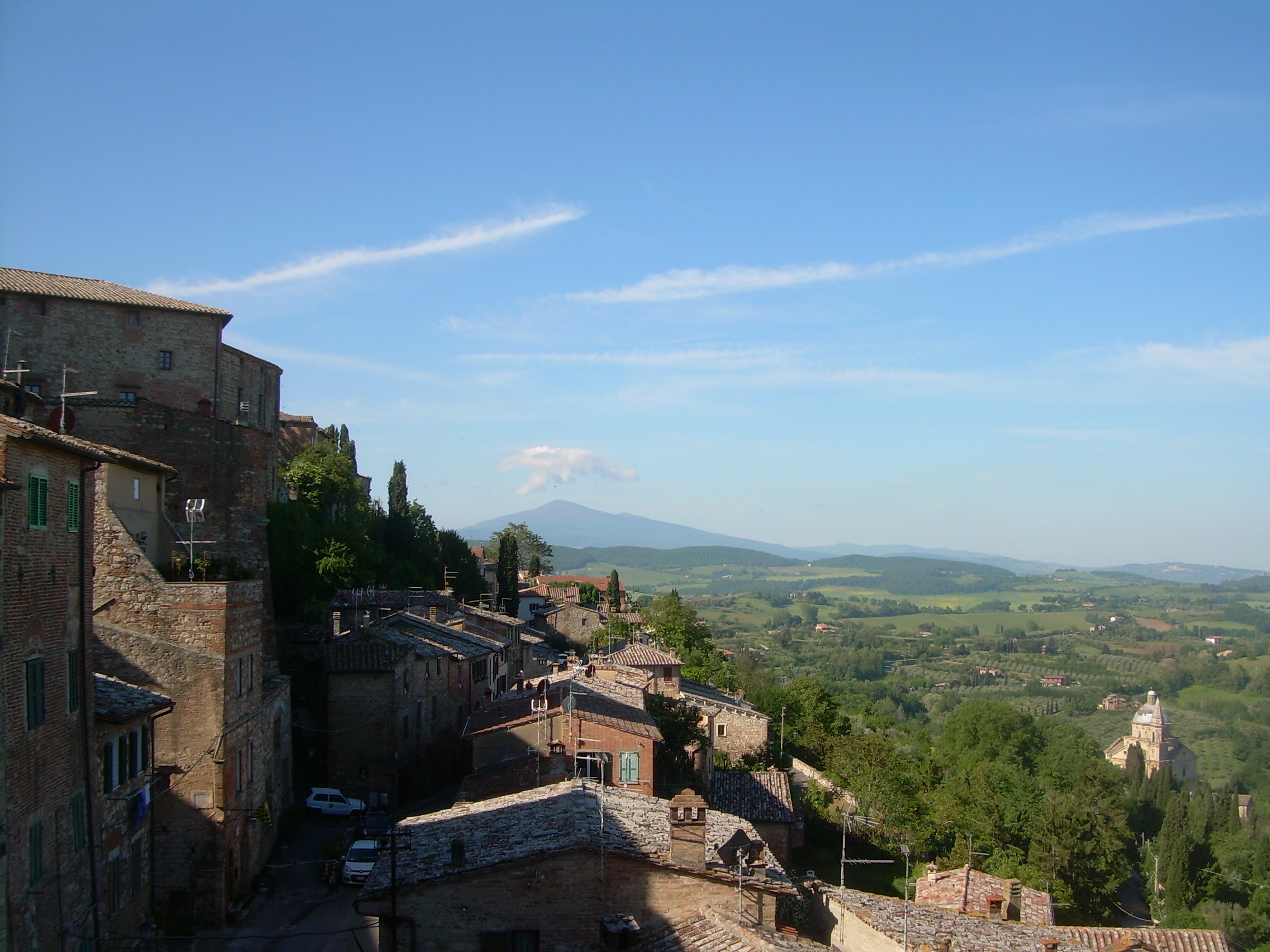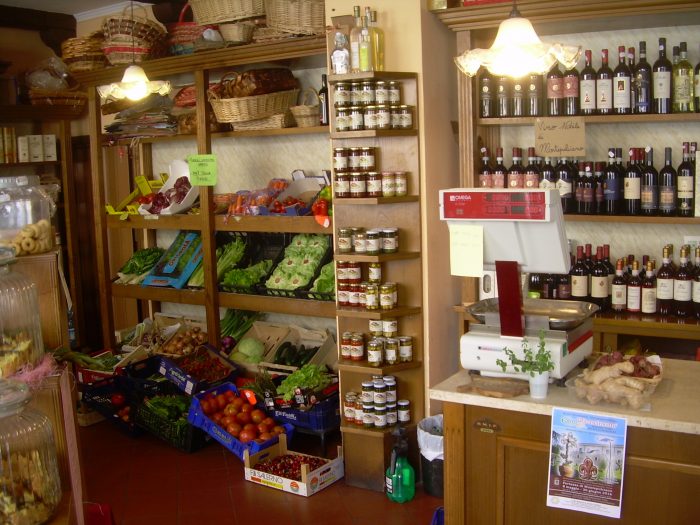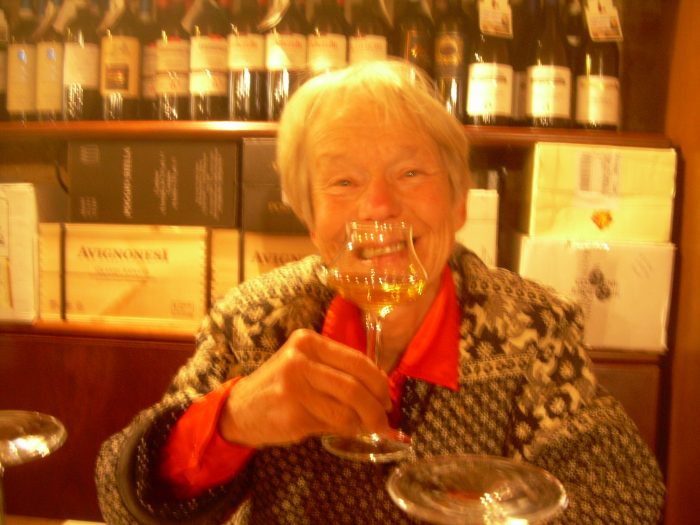What we enjoy about travel at this stage of our lives is to select a home base, settle in for a few days and just try to live in our adopted community. To do everything possible or desirable is not our plan. While in Sorrento, for example, we visited Pompeii, Herculaneum and Napoli but we did not climb Vesuvius, explore the romantic island of Capri, tour the spectacular Amalfi coast or make our way to the famous Greek ruins at Paestum.
Our only contacts with Rome were the views we saw as our train passed through. In Florence we went by taxi from the central station to a Hertz rental car office and then got out of town as fast and as directly as our little Lancia would take us. (We had driven in the old part of Florence once years before and had no desire to try that again.) On our way back we did the reverse. And we drove past the much-admired Sienna without stopping.
The car was for Tuscany, and in Tuscany our home was the hill town of Montepulciano. Montepulciano is also not a place to cruise in a car. It is a medieval and renaissance town with fourteen thousand folks perched on a long, narrow, outcropping of rock, enclosed here and there by old walls with narrow arched openings that give access to steep, narrow cobblestone streets full of pedestrians, many of whom are as lost, or more lost, than you are.
We parked in a public lot below the town at the north end and made our way through a gate and up some very steep streets in search of one called Via Ricci. On Via Ricci we hoped to find Camere Bellavista. where we had a reservation and which, good-old Rick Steves had told us, was owned and operated by Gabriella who, according to Rick, provided ten charming rooms with great views but spoke only a “smidgen” of English. We also understood that Gabriella did not live on site and that we should call her when we arrived, but, of course, we had no phone.
One end of Via Ricci begins at a quirky little locus with four other intersecting sloping streets including an arched gate. On one of the corner buildings was a sign that said Camere Bellavista. It seemed, at that moment, somewhat like a dream. Months before, and thousands of miles away, we had looked at pictures online, exchanged a couple of emails and made a reservation. The morning had begun at the Hotel Deseree in Sorrento hundreds of miles to the south, where the night before, because we were leaving before breakfast, Cassandra had packed us some fruit, bread and cheese for our journey. We had taken two taxi rides, two train rides, rented and driven a strange car for a couple of hours, gotten lost and begged for directions from truck drivers and service station attendants in fumbled Italian and English, found a parking place and figured out how to pay for it, climbed the steep streets into town searching for signs and now before us was the very entrance that months before we had seen in an online photo.
Next to the door was a buzzer, and when we pushed the buzzer, a voice answered and the lock on the door was released. We climbed a couple of flights of stairs, and there sitting in her office waiting for us was the famous and welcoming Gabriella.
Moments later she had us in her car with her elderly father. She drove us down to where we had parked and motioned us to follow her. Out and around the east side of town she went to the south end, then up a one-way switch-backed street past the fortress, down and through the Piazza Grande to a parking area near the San Francisco church, where, because she gave us a document for our dash, the little car would not be towed. We hauled ourselves and our luggage up six floors to our room. We stepped out onto the terrace and there before us in all its spring-green glory was the view we had come to see: the hills and valleys of Tuscany with their vineyards and flowers and cypress-lined roads, with other hill towns visible in the distance. And in the sky swallows swirling in search of their evening meal. A bella vista, indeed.

A View South from Montepulciano
We were seven days in Montepulciano. On four of them we ventured out by car to other destinations. The first took us to two stops along the Via Francignena, a pilgrimage route to Rome that has been followed since the 8th century: the gardens at La Foca where we took our only guided tour of the trip and Bagna Vignoni where we dutifully soaked our feet in the cool flowing water, as had so many before us. The second was to the hill towns of Pienza and Montalcino. Both were cute and well-populated with folks doing what we were doing. In Montalcino Nina climbed the tallest tower in the fortress; we had a mid-day meal that contained some exquisite pecorino cheese, the memory of which makes my mouth water even now; and we bought a bottle of the famous Brunello wine. Our third outing was to Orvieto down in Umbria where we had another great lunch and got to see that town’s amazing and gaudy church. On the way to Orvieto, somewhere around Chiusi just as we were about to drive off our Tuscany-only map, a man at a service station advised us to take a scenic route, which turned out to be very scenic but a tad longer than we would have preferred. Our final drive was to the tiny walled village of Monticchiello which is only a few miles down an unmarked, sometimes-gravel farm road from Montepulciano, a road that our bookish friend Rick Steves told us about. Monticchiello is home to two-hundred folks and reminded both of us of Austria because it was so orderly and well maintained. Near what had once been an outdoor public laundry, near the top of the town, we found some neat art displayed among trees in a field. Monticchiello has a famous restaurant but the wait was too long and we ended driving back “home” for our midday meal.
Funny how a place becomes “home” so quickly. You learn how to get into and out of it by car. You have a place to stay that has a refrigerator. You figure out the shower, the bed becomes familiar.
We discovered a tiny place in Montepulciano where every morning we went for coffee. The Bar Enoteca Pasticceria was run by one man and his customers were, so far as we could tell, almost all locals whom he seemed to know personally: construction workers, women on their way to work, etc. He soon greeted us with a smile and had our cappuccinos ready. We would find chairs at one of the two small tables, pick up a newspaper and act like we could make sense of articles about the then-happening Giro d’italia and the upcoming European soccer championships. The day before we left he told us that the next morning he was driving to the ocean and would be closed. When Nina wondered aloud where she would get her coffee, he handed her a few coffee beans.
We like to have breakfast in the room (fruit, muesli, yogurt, meat, cheese, trail mix), enjoy a midday meal in a restaurant and in the evening return to the room to feast on cheese, bread, cold cuts, leftovers from lunch and wine. Such a life-style requires three things: a tiny refrigerator, basic utensils and a market. Our utensils were scrounged: used yogurt containers, gelato spoons, a knife borrowed from Gabriella, etc.
A trip to a supermarket in a foreign country is best experienced as a treasure hunt, and in my mind they make for great travel adventures. First you have to find one and then you have to find your way around it while trying to decipher labels in a foreign language. (Being gluten-intolerant makes this especially interesting.)
They also tend to be busy, largely tourist-free and given to quirky oddities in the way they organize their inventories and price their products. (At our favorite market in Austria if you want an apple you set it on a machine, type in the number for type of apple and the machine weighs the apple and spits out a label with the weight and price that you stick to the apple and take to the cashier.)
In Montepulciano the market was called Conad and was found off the highway at the bottom of town a few hundred yards from where we had originally parked. So, after our Cappuccinos that first day, we spent much of the morning searching for and then prowling around in the market and finally lugging our goodies up the hill to our room for a late breakfast.
We had two favorite restaurants in Montepulciano, each of which we visited multiple times. One, the Osteria del Borgo was just up the street from our room and just below the Piazza Grande. Nina and I chose it for the meal that celebrated the forty-fourth anniversary. The owner, a charming fellow who spoke good English treated us very well. He gave us an outside table with a great view, and then when it got too cold and dark led us to a table indoors that he had held in reserve for us. He even poured and delivered to our table free grappas in honor of our anniversary. We came to know the staff there including the owner’s father a retired policeman who cleared tables and delivered bread. The father spoke no English and when I tried to say something to him in Italian he gave me a blank look as if to say: “And just what language is that you are trying to speak?”
The other was a wine bar and bistro called “E lucevan le stella.” We enjoyed wine flights there both inside and out and had wonderful salads and great service from a waiter named Christian.
A third interesting place where we had wine and free hors ‘d ourves was the Caffe Poliziano which dates from 1868 and offers great views of the hills and valley east of town. Federico Fellini is said to have admired its ambiance.
When we weren’t eating or drinking or driving to other locations we wondered around our “home” town.

A Small Shop on the Corso
At the fortress one night we met a man from Florence who was an architect and inventor. His interest was solar power and how it could be used to transform cities to make them quieter and more sustainable. He was exhibiting a number of solar-powered sculptures while upstairs his wife or partner had organized a painting exhibition. We had several interesting conversations with them during our week in Montepulciano. He was the man who said to me. “You Americans laughed at us when we had Berlusconi but now you are considering Donald Trump!”
One day in the Piazza Grande we listened to a couple of musicians. The woman was a flutist from Italy and the man a guitarist from Brazil. We bought a couple of their CDs and are still enjoying them. That evening we attended a student concert in a gorgeous chamber in the Palazzo Ricci involving a string quartet, several singers and two pianists. The next evening we returned to the same room to see a play that was locally written and locally performed. It was a farce, in Italian, of course, and we understood virtually not a word but it was a kick to watch the performers and the audience composed largely of the performers’ families and friends.
Another afternoon we descended a spiral staircase that led to a series of dark, cool caverns where deep in the rock beneath the town you find huge barrels of wine patently aging.
In the valley just outside of town is a church, San Biagio, that Rick describes as “Renaissance perfection.” Rick is not exaggerating as we discovered the first day we decided to walk down and check it out. The hike was a half-hour along a pleasant tree-lined road but the church was well-worth the walk down and the climb back up. The building, set in a pleasant grassy lawn is designed as a Greek cross, meaning that its four arms are of equal length. For a while that morning we were alone inside. Nina stood at the very the center and sang a few notes. The acoustics were so amazing that she sounded like a choir when her voice came back to us from all directions at slightly different intervals.
“On Sunday,” she announced, “we have to attend a service.”
So, of course, that is what we did. We found a sign somewhere that the service would be at eleven. But at ten that morning church bells started ringing like crazy and as usual we were confused. Gabriella had no idea about the time of the service but offered to drive us there. No, we would walk. So, I threw on the daypack and off we went.
When we got there the place was nearly empty so we sat down in a pew to wait. A man was practicing on a small portable electronic organ which was a major disappointment since we wanted to hear the “real” organ in there. But then people started showing up. Men in stylish dark suits with white shirts and dark ties, women in high heels, most wearing interesting, some amazing outfits, and lots of children. Families and friends greeted one another with embraces and the brushing of cheeks.
Among the children were thirteen boys and girls around the age of puberty who were distinguished by white robes secured with white ropes around their waists. A small choir was practicing now with the organist. More chairs were brought out and ever more people continued to arrive as we slowly retreated to what we hoped would be less obtrusive niches.
By eleven every seat was taken and a hundred or more folks stood along the edges. This was not going to be a typical Sunday service, we realized, It was, it turned out, a celebration of the first communion for the thirteen white-robed children: Prima comunione dei bambini della parrocchia, and people from all over the parish had come to welcome the children and to share the experience with them. It was a warm celebration of family and community that we had the honor to watch from our corner of the sanctuary.

Saluti!

